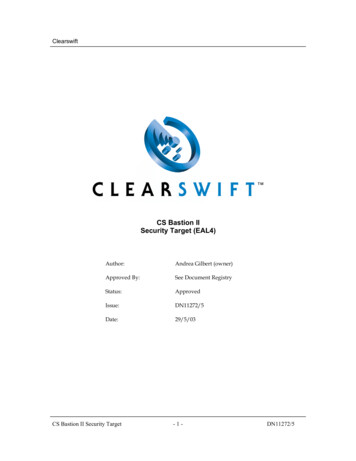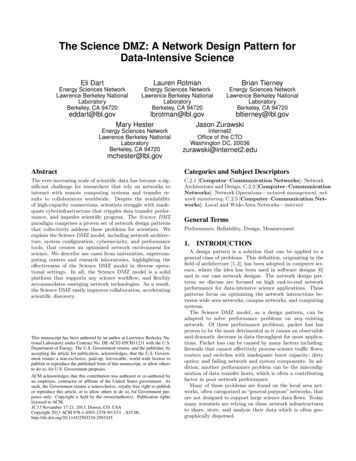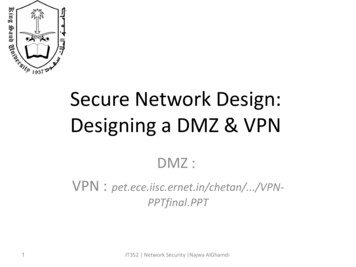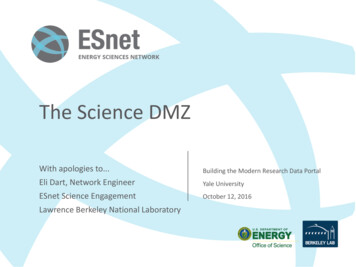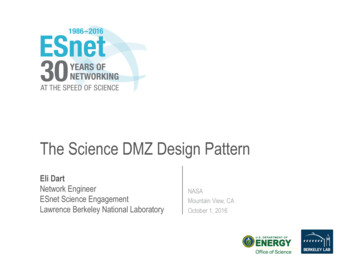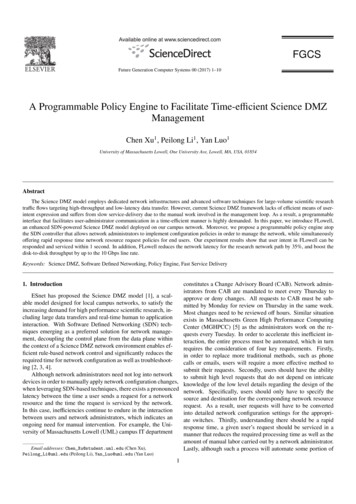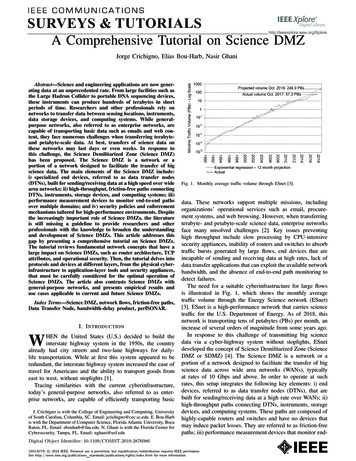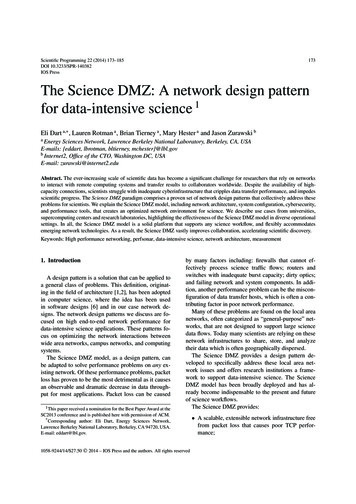
Transcription
Scientific Programming 22 (2014) 173–185DOI 10.3233/SPR-140382IOS Press173The Science DMZ: A network design patternfor data-intensive science 1Eli Dart a, , Lauren Rotman a , Brian Tierney a , Mary Hester a and Jason Zurawski ba Energy Sciences Network, Lawrence Berkeley National Laboratory, Berkeley, CA, USAE-mails: {eddart, lbrotman, bltierney, mchester}@lbl.govb Internet2, Office of the CTO, Washington DC, USAE-mail: zurawski@internet2.eduAbstract. The ever-increasing scale of scientific data has become a significant challenge for researchers that rely on networksto interact with remote computing systems and transfer results to collaborators worldwide. Despite the availability of highcapacity connections, scientists struggle with inadequate cyberinfrastructure that cripples data transfer performance, and impedesscientific progress. The Science DMZ paradigm comprises a proven set of network design patterns that collectively address theseproblems for scientists. We explain the Science DMZ model, including network architecture, system configuration, cybersecurity,and performance tools, that creates an optimized network environment for science. We describe use cases from universities,supercomputing centers and research laboratories, highlighting the effectiveness of the Science DMZ model in diverse operationalsettings. In all, the Science DMZ model is a solid platform that supports any science workflow, and flexibly accommodatesemerging network technologies. As a result, the Science DMZ vastly improves collaboration, accelerating scientific discovery.Keywords: High performance networking, perfsonar, data-intensive science, network architecture, measurement1. IntroductionA design pattern is a solution that can be applied toa general class of problems. This definition, originating in the field of architecture [1,2], has been adoptedin computer science, where the idea has been usedin software designs [6] and in our case network designs. The network design patterns we discuss are focused on high end-to-end network performance fordata-intensive science applications. These patterns focus on optimizing the network interactions betweenwide area networks, campus networks, and computingsystems.The Science DMZ model, as a design pattern, canbe adapted to solve performance problems on any existing network. Of these performance problems, packetloss has proven to be the most detrimental as it causesan observable and dramatic decrease in data throughput for most applications. Packet loss can be caused1 This paper received a nomination for the Best Paper Award at theSC2013 conference and is published here with permission of ACM.* Corresponding author: Eli Dart, Energy Sciences Network,Lawrence Berkeley National Laboratory, Berkeley, CA 94720, USA.E-mail: eddart@lbl.gov.by many factors including: firewalls that cannot effectively process science traffic flows; routers andswitches with inadequate burst capacity; dirty optics;and failing network and system components. In addition, another performance problem can be the misconfiguration of data transfer hosts, which is often a contributing factor in poor network performance.Many of these problems are found on the local areanetworks, often categorized as “general-purpose” networks, that are not designed to support large sciencedata flows. Today many scientists are relying on thesenetwork infrastructures to share, store, and analyzetheir data which is often geographically dispersed.The Science DMZ provides a design pattern developed to specifically address these local area network issues and offers research institutions a framework to support data-intensive science. The ScienceDMZ model has been broadly deployed and has already become indispensable to the present and futureof science workflows.The Science DMZ provides:1058-9244/14/ 27.50 2014 – IOS Press and the authors. All rights reserved A scalable, extensible network infrastructure freefrom packet loss that causes poor TCP performance;
174E. Dart et al. / The Science DMZ: A network design pattern for data-intensive science Appropriate usage policies so that highperformance applications are not hampered byunnecessary constraints; An effective “on-ramp” for local resources to access wide area network services; and Mechanisms for testing and measuring, therebyensuring consistent performance.This paper will discuss the Science DMZ from itsdevelopment to its role in future technologies. First,Section 2 will discuss the Science DMZ’s originaldevelopment in addressing the performance of TCPbased applications. Second, Section 3 enumerates thecomponents of the Science DMZ model and how eachcomponent adds to the overall paradigm. Next, Sections 4 and 5 offer some sample illustrations of networks that vary in size and purpose. Following, Section 6 will discuss some examples of Science DMZ implementations from the R&E community. And lastly,Section 7 highlights some future technological advancements that will enhance the applicability of theScience DMZ design.2. MotivationWhen developing the Science DMZ, several keyprinciples provided the foundation to its design. First,these design patterns are optimized for science. Thismeans the components of the system – including allthe equipment, software and associated services – areconfigured specifically to support data-intensive science. Second, the model is designed to be scalable inits ability to serve institutions ranging from large experimental facilities to supercomputing sites to multidisciplinary research universities to individual researchgroups or scientists. The model also scales to serve agrowing number of users at those facilities with an increasing and varying amount of data over time. Lastly,the Science DMZ model was created with future innovation in mind by providing the flexibility to incorporate emerging network services. For instance, advancesin virtual circuit services, 100 Gigabit Ethernet, andthe emergence of software-defined networking presentnew and exciting opportunities to improve scientificproductivity. In this section, we will mostly discuss thefirst principle since it is the driving mission for the Science DMZ model.The first principle of the model is to optimize thenetwork for science. To do this, there are two entitiesor areas of the network that should be considered: thewide area network and the local area networks. Thewide area networks (or WANs) are often already optimized and can accommodate large data flows up to100 Gbps. However, the local area networks are still achoke point for these large data flows.Local area networks are usually general-purposenetworks that support multiple missions, the first ofwhich is to support the organization’s business operations including email, procurement systems, webbrowsing, and so forth. Second, these general networksmust also be built with security that protects financial and personnel data. Meanwhile, these networksare also used for research as scientists depend on thisinfrastructure to share, store, and analyze data frommany different sources. As scientists attempt to runtheir applications over these general-purpose networks,the result is often poor performance, and with the increase of data set complexity and size, scientists oftenwait hours, days, or weeks for their data to arrive.Since many aspects of general-purpose networks aredifficult or impossible to change in the ways necessaryto improve their performance, the network architecturemust be adapted to accommodate the needs of scienceapplications without affecting mission critical businessand security operations. Some of these aspects that aredifficult to change might include the size of the memory buffers for individual interfaces; mixed traffic patterns between mail and web traffic that would includescience data; and emphasis on availability vs. performance and what can be counted on over time for network availability.The Science DMZ model has already been implemented at various institutions to upgrade thesegeneral-purpose, institutional networks. The NationalScience Foundation (NSF) recognized the ScienceDMZ as a proven operational best practice for university campuses supporting data-intensive science andspecifically identified this model as eligible for funding through the Campus Cyberinfrastructure–NetworkInfrastructure and Engineering Program (CC–NIE).2This program was created in 2012 and has since beenresponsible for implementing approximately 20 Science DMZs at different locations – thereby serving theneeds of the science community. Another NSF solicitation was released in 2013 and awards to fund a similarnumber of new Science DMZ’s are expected.2 NSF’s CC–NIE pubs/2013/
E. Dart et al. / The Science DMZ: A network design pattern for data-intensive science175Fig. 1. Graph shows the TCP throughput vs. round-trip time (latency) with packet loss between 10 Gbps connected hosts, as predicted by theMathis Equation. The topmost line (shown in purple) shows the throughput for TCP in a loss-free environment. (The colors are visible in theonline version of the article; http://dx.doi.org/10.3233/SPR-140382.)2.1. TCP performanceThe Transmission Control Protocol (TCP) [15] ofthe TCP/IP protocol suite is the primary transport protocol used for the reliable transfer of data between applications. TCP is used for email, web browsing, andsimilar applications. Most science applications are alsobuilt on TCP, so it is important that the networks areable to work with these applications (and TCP) to optimize the network for science.TCP is robust in many respects – in particular it hassophisticated capabilities for providing reliable datadelivery in the face of packet loss, network outages,and network congestion. However, the very mechanisms that make TCP so reliable also make it perform poorly when network conditions are not ideal. Inparticular, TCP interprets packet loss as network congestion, and reduces its sending rate when loss is detected. In practice, even a tiny amount of packet loss isenough to dramatically reduce TCP performance, andthus increase the overall data transfer time. When applied to large tasks, this can mean the difference between a scientist completing a transfer in days ratherthan hours or minutes. Therefore, networks that support data-intensive science must provide TCP-basedapplications with loss-free service if TCP-based applications are to perform well in the general case.As an example of TCP’s sensitivity, consider the following case. In 2012, Department of Energy’s (DOE)Energy Sciences Network (ESnet) had a failing 10Gbps router line card that was dropping 1 out of 22,000packets, or 0.0046% of all traffic. Assuming the linecard was working at peak efficiency, or 812,744 regular sized frames per second,3 37 packets were lost each3 Performance Metrics, ce/network performance metrics.html.second due to the loss rate. While this only resultedin an overall drop of throughput of 450 Kbps (on thedevice itself), it reduced the end-to-end TCP performance far more dramatically as demonstrated in Fig. 1.This packet loss was not being reported by the router’sinternal error monitoring, and was only noticed usingthe owamp active packet loss monitoring tool, which ispart of the perfSONAR Toolkit.4Because TCP interprets the loss as network congestion, it reacts by rapidly reducing the overall sendingrate. The sending rate then slowly recovers due to thedynamic behavior of the control algorithms. Networkperformance can be negatively impacted at any pointduring the data transfer due to changing conditions inthe network. This problem is exacerbated as the latency increases between communicating hosts. This isoften the case when research collaborations sharingdata are geographically distributed. In addition, feedback regarding the degraded performance takes longerto propagate between the communicating hosts.The relationship between latency, data loss, and network capability was described by Mathis et al. as amechanism to predict overall throughput [12]. The“Mathis Equation” states that maximum TCP throughput is at most:1maximum segment size .round-trip timepacket loss rate(1)Figure 1 shows the theoretical rate predicted by theMathis Equation, along with the measured rate for bothTCP-Reno and TCP-Hamilton across ESnet. These4 perfSONAR Toolkit: http://psps.perfsonar.net.
176E. Dart et al. / The Science DMZ: A network design pattern for data-intensive sciencetests are between 10 Gbps connected hosts configuredto use 9 KByte (“Jumbo Frame”) Maximum Transmission Units (MTUs).This example is indicative of the current operational reality in science networks. TCP is used forthe vast majority of high-performance science applications. Since TCP is so sensitive to loss, a science network must provide TCP with a loss-free environment,end-to-end. This requirement, in turn, drives a set ofdesign decisions that are key components of the Science DMZ model.3. The science DMZ design patternThe overall design pattern or paradigm of the Science DMZ is comprised of four sub-patterns. Each ofthese sub-patterns offers repeatable solutions for fourdifferent areas of concern: proper location (in networkterms) of devices and connections; dedicated systems;performance measurement; and appropriate securitypolicies. These four sub-patterns will be discussed inthe following subsections.3.1. Proper location to reduce complexityThe physical location of the Science DMZ (or “location design pattern") is important to consider duringthe deployment process. The Science DMZ is typicallydeployed at or near the network perimeter of the institution. The reason for this is that it is important toinvolve as few network devices as reasonably possiblein the data path between the experiment at a sciencefacility, the Science DMZ, and the WAN.Network communication between applications running on two hosts traverses, by definition, the hoststhemselves and the entire network infrastructure between the hosts. Given the sensitivity of TCP to packetloss (as discussed in Section 2.1), it is important to ensure that all the components of the network path between the hosts are functioning properly and configured correctly. Wide area science networks are typically engineered to perform well for science applications, and in fact the Science DMZ model assumes thatthe wide area network is doing its job. However, thelocal network is often complex, and burdened with thecompromises inherent in supporting multiple competing missions. The location design pattern accomplishestwo things. The first is separation from the rest of thegeneral network, and the second is reduced complexity.There are several reasons to separate the highperformance science traffic from the rest of the network. The support of high-performance applicationscan involve the deployment of highly capable equipment that would be too expensive to use throughout thegeneral-purpose network but that has necessary features such as high-performance filtering capabilities,sufficient buffering for burst capacity, and the ability toaccurately account for packets that traverse the device.In some cases, the configuration of the network devicesmust be changed to support high-speed data flows – anexample might be conflict between quality of servicesettings for the support of enterprise telephony and theburst capacity necessary to support long-distance highperformance data flows. In addition, the location pattern makes the application of the appropriate securitypattern significantly easier (see Section 3.4).The location design pattern can also significantlyreduce the complexity of the portion of the networkused for science applications. Troubleshooting is timeconsuming, and there is a large difference in operational cost and time-to-resolution between verifyingthe correct operation of a small number of routers andswitches and tracing the science flow through a largenumber of network devices in the general-purpose network of a college campus. For this reason, the Science DMZ is typically located as close to the networkperimeter as possible, i.e. close to or directly connectedto the border router that connects the research institution’s network to the wide area science network.3.2. Dedicated systems: The Data Transfer Node(DTN)Systems used for wide area science data transfersperform far better if they are purpose-built for and dedicated to this function. These systems, which we calldata transfer nodes (DTNs), are typically PC-basedLinux servers constructed with high quality components and configured specifically for wide area datatransfer. The DTN also has access to storage resources,whether it is a local high-speed disk subsystem, a connection to a local storage infrastructure, such as a storage area network (SAN), or the direct mount of a highspeed parallel file system such as Lustre5 or GPFS.6The DTN runs the software tools used for high-speeddata transfer to remote systems. Some typical softwarepackages include GridFTP7 [3] and its service-oriented5 Lustre, http//www.lustre.org/.6 GPFS, http://www.ibm.com/systems/software/gpfs/.7 GridFTP, http://www.globus.org/datagrid/gridftp.html.
E. Dart et al. / The Science DMZ: A network design pattern for data-intensive sciencefront-end Globus Online8 [4], discipline-specific toolssuch as XRootD,9 and versions of default toolsets suchas SSH/SCP with high-performance patches10 applied.DTNs are widely applicable in diverse science environments. For example, DTNs are deployed to support Beamline 8.3.2 at Berkeley Lab’s Advanced LightSource,11 and as a means of transferring data to andfrom a departmental cluster. On a larger scale, setsof DTNs are deployed at supercomputer centers (forexample at the DOE’s Argonne Leadership Computing Facility,12 the National Energy Research ScientificComputing Center,13 and Oak Ridge Leadership Computing Facility14 ) to facilitate high-performance transfer of data both within the centers and to remote sites.At even larger scales, large clusters of DTNs providedata service to the Large Hadron Collider (LHC)15 collaborations. The Tier-116 centers deploy large numbersof DTNs to support thousands of scientists. These aresystems dedicated to the task of data transfers so thatthey provide reliable, high-performance service to science applications.17DTNs typically have high-speed network interfaces,but the key is to match the DTN to the capabilities ofthe wide area network infrastructure. For example, ifthe network connection from the site to the WAN is1 Gigabit Ethernet, a 10 Gigabit Ethernet interface onthe DTN may be counterproductive. The reason for thisis that a high-performance DTN can overwhelm theslower wide area link causing packet loss.The set of applications that run on a DTN is typically limited to parallel data transfer applications likeGridFTP or FDT.18 In particular, user-agent applications associated with general-purpose computing andbusiness productivity (e.g., email clients, document editors, media players) are not installed. This is for tworeasons. First, the dedication of the DTN to data transfer applications produces more consistent behavior andavoids engineering trade-offs that might be part of supporting a larger application set. Second, data transferapplications are relatively simple from a network secu8 Globus Online, https://www.globusonline.org/.9 XRootD, http://xrootd.slac.stanford.edu/.10 HPN-SSH, http://www.psc.edu/networking/projects/hpn-ssh/.11 LBNL ALS, http://www-als.lbl.gov.12 ALCF, https://www.alcf.anl.gov.177rity perspective, and this makes the appropriate security policy easier to apply (see Section 3.4).Because the design and tuning of a DTN can betime-consuming for small research groups, ESnet hasa DTN Tuning guide19 and a Reference DTN Implementation guide.20 The typical engineering trade-offsbetween cost, redundancy, performance and so on. apply when deciding on what hardware to use for a DTN.In general, it is recommended that DTNs be procuredand deployed such that they can be expanded to meetfuture storage requirements.3.3. Performance monitoringPerformance monitoring is critical to the discovery and elimination of so-called “soft failures” in thenetwork. Soft failures are problems that do not causea complete failure that prevents data from flowing(like a fiber cut), but causes poor performance. Examples of soft failures include packet loss due to failing components; dirty fiber optics; routers forwarding packets using the management CPU rather thanthe high-performance forwarding hardware; and inadequate hardware configuration. Soft failures often goundetected for many months or longer, since most network management and error reporting systems are optimized for reporting “hard failures”, such as loss ofa link or device. Also, many scientists do not knowwhat level of performance to expect, and so they do notknow when to alert knowledgeable staff about a potential problem.A perfSONAR host [16] helps with fault diagnosis on the Science DMZ. It offers end-to-end testingwith collaborating sites that have perfSONAR tools installed, which allows for multi-domain troubleshooting. perfSONAR is a network monitoring softwaresuite designed to conduct both active and passive network measurements, convert these to a standard format, and then publish the data so it is publicly accessible. The perfSONAR host can run continuous checksfor latency changes and packet loss using OWAMP,21as well as periodic “throughput” tests (a measure ofavailable network bandwidth) using BWCTL.22 If aproblem arises that requires a network engineer totroubleshoot the routing and switching infrastructure,13 NERSC, http://www.nersc.gov.14 OLCF, http://www.olcf.ornl.gov/.15 LHC, http://lhc.web.cern.ch/lhc/.16 US/LHC,http://www.uslhc.us/The US and the LHC/Computing.17 LHCOPN, http://lhcopn.web.cern.ch/lhcopn/.18 FTD, http://monalisa.cern.ch/FDT/.19 /tuning/.20 ReferenceDTN, node-reference-implementation/.21 OWAMP, http://www.internet2.edu/performance/owamp/.22 BWCTL, http://www.internet2.edu/performance/bwctl/.
178E. Dart et al. / The Science DMZ: A network design pattern for data-intensive scienceFig. 2. Regular perfSONAR monitoring of the ESnet infrastructure.The color scales denote the “degree” of throughput for the data path.Each square is halved to show the traffic rate in each direction between test hosts. (Colors are visible in the online version of the article; http://dx.doi.org/10.3233/SPR-140382.)the tools necessary to work the problem are alreadydeployed – they need not be installed before troubleshooting can begin.By deploying a perfSONAR host as part of the Science DMZ architecture, regular active network testingcan be used to alert network administers when packetloss rates increase, or throughput rates decrease. Thisis demonstrated by “dashboard” applications, as seenin Fig. 2. Timely alerts and effective troubleshootingtools significantly reduce the time and effort requiredto isolate the problem and resolve it. This makes highperformance the norm for science infrastructure, andprovides significant productivity advantages for dataintensive science experiments.3.4. Appropriate securityNetwork and computer security are of critical importance for many organizations. Science infrastructures are no different than any other information infrastructure. They must be secured and defended. The National Institute for Standards and Technology (NIST)framework for security uses the CIA concepts – Confidentiality, Integrity, and Availability.23 Data-intensivescience adds another dimension – performance. If thescience applications cannot achieve adequate performance, the science mission of the infrastructure hasfailed. Many of the tools in the traditional network security toolbox do not perform well enough for use inhigh-performance science environments. Rather thancompromise security or compromise performance, the23 FIPS-199, ience DMZ model addresses security using a multipronged approach.The appropriate security pattern is heavily dependent on the location and the dedicated systems patterns. By deploying the Science DMZ in a separate location in the network topology, the traffic in the Science DMZ is separated from the traffic on the rest ofthe network (i.e., email, etc.), and security policy andtools can be applied specifically to the science-onlytraffic on the Science DMZ. The use of dedicated systems limits the application set deployed on the ScienceDMZ, and also reduces the attack surface.A comprehensive network security capability usesmany tools and technologies, including network andhost intrusion detection systems, firewall appliances,flow analysis tools, host-based firewalls, router accesscontrol lists (ACLs), and other tools as needed. Appropriate security policies and enforcement mechanismsare designed based on the risk levels associated withhigh-performance science environments and built using components that scale to the data rates requiredwithout causing performance problems. Security for adata-intensive science environment can be tailored forthe data transfer systems on the Science DMZ.Science DMZ resources are designed to interactwith external systems, and are isolated from (or havecarefully managed access to) internal systems. Thismeans the security policy for the Science DMZ can betailored for this purpose. Users at the local site who access resources on their local Science DMZ through thelab or campus perimeter firewall will typically get reasonable performance, since the latency between the local users and the local Science DMZ is low (even if thefirewall causes some loss), TCP can recover quickly.4. Sample designsAs a network design paradigm, the individual patterns of the Science DMZ can be combined in manydifferent ways. The following examples of the overallScience DMZ model are presented as illustrations ofthe concepts using notional network diagrams of varying size and functionality.4.1. Simple Science DMZA simple Science DMZ has several essentialcomponents. These include dedicated access to highperformance wide area networks, high-performancenetwork equipment, DTNs, and monitoring infrastruc-
E. Dart et al. / The Science DMZ: A network design pattern for data-intensive scienceFig. 3. Example of the simple Science DMZ. Shows the data paththrough the border router and to the DTN (shown in green). Thecampus site access to the Science DMZ resources is shown in red.(The colors are visible in the online version of the article; http://dx.doi.org/10.3233/SPR-140382.)ture provided by perfSONAR. These components areorganized in an abstract diagram with data paths inFig. 3.The DTN is connected directly to a highperformance Science DMZ switch or router, which isattached to the border router. By attaching the ScienceDMZ to the border router, it is much easier to guarantee a packet loss free path to the DTN, and to create virtual circuits that extend all the way to the endhost. The DTN’s job is to efficiently and effectivelymove science data between the local environment andremote sites and facilities. The security policy enforcement for the DTN is done using access control lists(ACLs) on the Science DMZ switch or router, not on aseparate firewall. The ability to create a virtual circuitall the way to the host also provides an additional layerof security. This design is suitable for the deploymentof DTNs that serve individual research projects or tosupport one particular science application. An example use case of the simple Science DMZ is discussedin Sections 6.1 and 6.2.179Fig. 4. Example supercomputer center built as a Science DMZ. (Colors are visible in the online version of the article; http://dx.doi.org/10.3233/SPR-140382.)high-rate data flows without packet loss, and designedto allow easy troubleshooting and fault isolation. Testand measurement systems are integrated into the infrastructure from the beginning, so that problems canbe located and resolved quickly, regardless of whetherthe local infrastructure is at fault. Note also that accessto the parallel filesystem by wide area data transfersis via data transfer nodes that are dedicated to widearea data transfer tasks. When data sets are transferredto the DTN and written to the parallel filesystem, thedata sets are immediately available on the supercomputer resources without the need for double-copyingthe data. Furthermore, all the advantages of a DTN –i.e., dedicated hosts, proper tools, and correct configuration – are preserved. This is also an advantage inthat the login nodes for a supercomputer need not havetheir configurations modified to support wide area datatransfers to the supercomputer itself. Data arrives fromoutside the center via the DTNs and is written to thecentral filesystem. The supercomputer login nodes donot need to replicate the DTN functionality in orderto facilitate data ingestion. A use case is described inSection 6.4.4.3. Big data site4.2. Supercomputer center networkThe notional diagram shown in Fig. 4 illustrates asimplified supercomputer center network. While thismay not look much like the simple Science DMZ diagram in Fig. 3, the same principles are used in its design.Many supercomputer centers already use the Science DMZ model. Their networks are built to handleFor sites that handle very large data volumes (e.g.,for large-scale experiments such as the LHC), individual data transfer nodes are not enough. These sites deploy data transfer “clusters”, and these groups of machines serve data from multi-petabyte data storage systems. Still, the principles of the Science DMZ apply.Dedicated systems are still used for data transfer, andthe path to the wide area is clean, simple, and easy to
180E. Dart et al. / The Science DMZ: A network design patter
/ The Science DMZ: A network design pattern for data-intensive science tests are between 10 Gbps connected hosts configured touse 9 KByte("JumboFrame")MaximumTransmis-sion Units (MTUs). This example is indicative of the current opera-tional reality in science networks. TCP is used for the vast majority of high-performance science applica .


